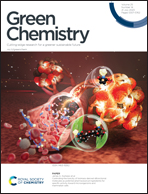Aerobic oxidation of alcohols using a slurry loop membrane reactor†
Abstract
The use of molecular oxygen is unquestionably the green path to the selective oxidation of alcohols to aldehyde and ketones. However, this reaction class poses safety problems associated with mixing oxygen with organic substrates. Continuous membrane reactors offer an attractive solution, owing to their ability to keep the oxygen phase separated from the liquid substrate, while controlling the dosing of oxygen during reaction. In this work, we demonstrate a slurry loop membrane reactor for continuous oxidations as well as hydrogenations. The catalyst slurry was circulated around a loop, to which a saturator containing a flat Teflon AF-2400 membrane was connected, along with a crossflow filter to keep the catalyst particles within the loop. Under a recycle flowrate 100 times higher than the inlet, the residence time distribution was found to be comparable to that of an ideal CSTR. A remarkably high kLa of 1.2 s−1 was achieved under a moderate specific power input of 2.4 kW m−3 during styrene hydrogenation. Continuous aerobic oxidations of various primary and secondary alcohols were carried out for 6–7 h at 90–120 °C and 2–6 bar, using a 1 wt% Au-Pd/TiO2 powder catalyst, leading to conversions between 17% and 75%. The reactor could also be operated in batch mode, achieving higher conversions, while scaled-up operations produced aldehyde yields of 0.4–19 g with only 88 mg of catalyst. Overall, the slurry loop membrane reactor provides significant advantages in terms of catalyst usage and process safety for aerobic oxidations.

- This article is part of the themed collection: 2023 Green Chemistry Hot Articles


 Please wait while we load your content...
Please wait while we load your content...